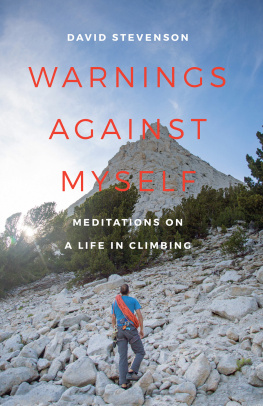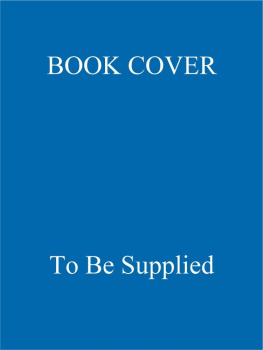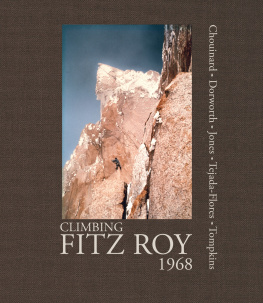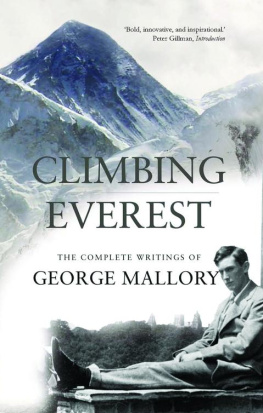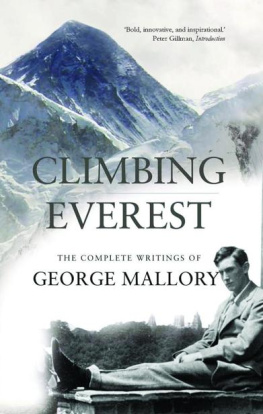
WARNINGS AGAINST MYSELF
DAVID STEVENSON
WARNINGS AGAINST MYSELF
MEDITATIONS ON A LIFE IN CLIMBING

UNIVERSITY OF WASHINGTON PRESS
Seattle and London
2016 by David Stevenson
Printed and bound in the United States of America
Design by Thomas Eykemans
Composed in Cassia, typeface designed by Dieter Hofrichter
Display type set in Montserrat, designed by Julieta Ulanovsky
20 19 18 17 16 5 4 3 2 1
Photographs are the property of David Stevenson unless credited otherwise.
All rights reserved. No part of this publication may be reproduced or transmitted in any form or by any means, electronic or mechanical, including photocopy, recording, or any information storage or retrieval system, without permission in writing from the publisher.
UNIVERSITY OF WASHINGTON PRESS
www.washington.edu/uwpress
Cataloging information is on file with the Library of Congress
ISBN 978-0-295-99553-3
The paper used in this publication is acid-free and meets the minimum requirements of American National Standard for Information SciencesPermanence of Paper for Printed Library Materials, ANSI Z39.481984.
For my sons,
Macklin Stevenson
19932015
Slow your roll and hold your own
A million miles, a million roads.
Macklin Stevenson
and
Dougal Stevenson
Even though we navigate daily through a perceptual world of three spatial dimensions and reason occasionally about higher dimensional arenas with mathematical ease, the world portrayed on our information displays is caught up in the two-dimensionality of the endless flatlands of paper and video screen. All communication between readers of an image and the makers of an image must now take place on a two-dimensional surface. Escaping this flatland is the essential task of envisioning informationfor all the interesting worlds (physical, biological, imaginary, human) that we seek to understand are inevitably and happily multivariate in nature. Not flatlands.
Edward Tufte, Envisioning Information
Contents
WARNINGS AGAINST MYSELF

INTRODUCTION
Since it is certainly not customary for an author to discuss his own work, perhaps a word of apology, or at least an explanation should occupy first place.
Thomas Mann, The Making of The Magic Mountain, 1953
Warnings against Myself accrued essay by essay over more than twenty-five years, beginning in about 1989. I began climbing in 1971. By 1989, some of the events I was writing about had already been unruly residents in the treasure house of memory for eighteen years.
If taken as a whole, they might be read as a kind of mountaineering memoir. If so, it is one that leaves out enormous amounts of my life, such as my family life and my working life, all of which unfolded in the foreground while my mountaineering life occurred mostly in the margins or waited in the wings.
But I never set out to write a memoir, nor have I done so.
The writing is not chronological, nor necessarily linear. Most of the essaysthe ones I like best anywaymight best be described as recursive. Ive added as postscripts the year the essays were written and a note from the present reflecting on how they strike me now. The more recent essays require less commentary.
I set out to write literary essays, by which I mean something more sophisticated than a traditional mountaineering trip report. The reports collected in the annual American Alpine Journal are models of this traditionally minimalistic and journalistic style. Those reports are usually limited to a single paragraph and concern themselves with most of the traditional questions of journalism: Who? What When? Where? How? Almost never does the Why? figure into these accounts, or even into much longer accounts, since this question is largely personal and understood as almost impossible to articulate anyway by most of the presumed audience. Joseph Conrad wrote of his novel Chance: No doubt that by selecting a certain method and taking great pains the whole story might have been written out on a cigarette paper. He was responding to critics who complained about the length of his works. American Alpine Journal trip reports could be written on a cigarette paper.
The piece titled Short Walks with McInerney: Three Classic Pilgrimages contains the least literarily ambitious of the pieces collected here: they are straightforward telling for the most part.
As it turns out, the Mount Kennedy trip has commanded an inordinate amount of space in my own memory and thus reappears in a number of essays, like a Magic 8 Ball that, when consulted, reveals the same fortune over and over: not It is certain, or Reply hazy, try again, but Mount Kennedy, Mount Kennedy, Mount Kennedy.
I understand completely David Robertss repeated recounting of his climb and tragedy of Mount Huntington in the Alaska Range in 1965. The book Mountain of My Fear, which launched his career, was written eight months after the climb, when he was twenty-two years old, in a white heat, a chapter a day, too impatient for second thoughts or serious revision. He also published four different accounts of the climb. And when he wrote his memoir On the Ridge between Life and Death: A Climbing Life Re-examined (2005), the Huntington trip appeared again. How could it not? As Roberts said of the climb, I have never lived through a five-day span of comparable intensity. Such intensity occupies much more than five days worth of memory.
I present these observations to defend the fact that in these essays, events and people reappear. Jorge Luis Borges said that the really great metaphors are always the same: You compare time to a road, death to sleeping, life to dreaming. Those are the great metaphors because they respond to something essential. My memories are not metaphors, but they are like them in their essentiality.
If I didnt set out to write these essays as a book, I did at least set out to write, just as I set out to climb. For many years climbing came more easily to me with its insistence on focus, its engagement of the senses, its immersion in the natural world. Prufrock measured out his life in coffee spoon; Terry Tempest Williams measured hers in birds, at least she did during the time recounted in Refuge; for me its mountains.
The challenges of the blank page were harder for me to commit to, a longer, slower road. Nonetheless, I have tried to adhere to Thoreaus dictum: If one advances confidently in the direction of his dreams, and endeavors to live the life which he has imagined, he will meet with a success unexpected in the common hours.
I dont know about confidently, and as far as success goes, all I know is that I continue to climb, and write, all in the direction of my dreams.
DDS
Anchorage, Alaska
September 2015

WARNINGS AGAINST MYSELF
In those early years, because of where we lived, climbing areas could be reached only by epic driving. We were Detroits children, growing up in the flat shadows of industry. And so, being young, we once drove nonstop, three days and nights, five of us in a Plymouth Duster, to Mexico City. Twenty years ago, the air was not nearly so polluted as now, and driving through the city, I remember seeing great white clouds above us and to the east. It was my first experience of my favorite illusion: the mistaking of high, snow-covered mountains for clouds. When we realized they were the very mountains we had come so far to climb, we were exhilaratedchildren at Christmasand we drove on through the village of Amecameca and up to Tlamacas, nestled between the great volcanoes Iztacchuatl and Popocatpetl.
Next page
